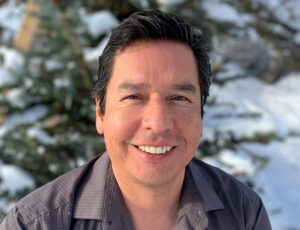Anishinaabe forestry professionals lend their voice to Industry e-book

By Rick Garrick
BONFIELD — Project Learning Tree Canada (PLT Canada) recently released the Anishinaabemowin translation of its A Guide to Green Jobs in Canada: Voices of Indigenous Professionals. The guide features the stories of 12 Indigenous leaders, including two Anishinaabe citizens, who work in the forest, conservation and parks sectors, as well as a series of career fact sheets.
“The revitalization of our cultures includes language — offering these translations is a way of acknowledging and respecting the culture and traditions of Indigenous peoples,” says Dean Assinewe, Indigenous opportunities advisor at Sustainable Forestry Initiative, Sagamok Anishnawbek citizen and one of the Indigenous leaders profiled in the guide. “It’s important to reach people in their first language, and we hope the guide can also be used as a learning tool for others who are trying to learn their language.”
Assinewe says he was working for FPInnovations when he was profiled for the guide.
“I’m a registered professional forester in Ontario and they reached out to me and asked me if I was willing to be a mentor to youth who are interested in the program as well as a future in the profession or a technical capacity in a green job like forestry,” Assinewe says. “The profile is basically a snapshot of how I came into my job as a forester — they asked me a series of questions about when I was young, what were the sort of things that were inspiring to me.”
Assinewe says he began pursuing his post-secondary goals when he was 26-years-old and graduated with a Forest Technician diploma at Sault College and an Honours Bachelor of Science in Forestry at Lakehead University.
“Right after college and university I went and worked for a short stint with the Ministry of Natural Resources in Thunder Bay,” Assinewe says. “After that, I worked for Mamaweswen, the North Shore Tribal Council in Blind River.”
Assinewe says he had to “reinvent himself” due to the downturn in the forest industry and did work in hydropower development, solar-power development and private consulting.
“In the green economy or in the green job space, our communities are really at the heart of natural resources, whether it’s forestry, whether it’s renewable energy,” Assinewe says. “I actually want to put an emphasis on agriculture because without food, we’re certainly at risk, so that becomes a large part of what Project Learning Tree Canada is also trying to encourage is sustainable food systems.”
PLT Canada is an initiative of the Sustainable Forestry Initiative.
“If First Nations can help take a lead in how development happens, Canada and the rest of the world will be better for it,” Assinewe states in the guide. “We have to draw careful connections between our environment, our culture and traditions, and how we develop our natural resources. On an individual basis, I can mentor youth who are trying to decide what they want to become. Growing up, we didn’t have many mentors like First Nation foresters. Today, there are more and more.”
Devin Hurcombe, an Anishinabek Nation citizen from Biigtigong Nishnaabeg and power engineer with Resolute Forest Products in Thunder Bay, was also profiled in the guide.
“My work in cogeneration ties to my heritage and teachings about being one with nature,” Hurcombe states in the guide. “Cogeneration is about using what you have and not wasting things. Whether it’s harvesting a deer or a tree, you’re not wasting things. Resolute is using the leftovers like bark, chips and sawdust to create power after making lumber or paper products. Nothing is wasted.”
Information about the guide is posted online.


